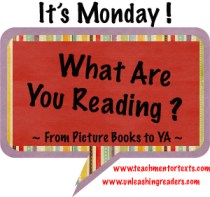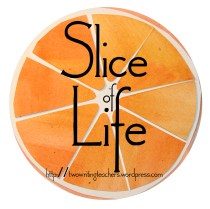It’s Monday, and this slice is once again doing double-duty for It’s Monday! What Are You Reading? Be sure to visit Jen at Teach Mentor Texts and Kellee at Unleashing Readers to find out what other people have been reading lately. Thanks, Jen and Kellee, for hosting!
Reading Anchor Standard nine of the CCSS states that students will “analyze how two or more texts address similar themes or topics in order to build knowledge or to compare the approaches the authors take.” At each grade level, this standard has a different specificity. In fourth grade, students are expected to “compare and contrast the treatment of similar themes and topics (e.g., opposition of good and evil) and patterns of events (e.g. the quest) in stories, myths, and traditional literature from different cultures.”
By the time they reach eighth grade, this expectation has become more complex. Now students must “analyze how a modern work of fiction draws on themes, patterns of events, or character types from myths, traditional stories, or religious works such as the Bible, including describing how the material is rendered new.”
I’m focusing on this standard in particular because it is such a shift from the previous expectation in the Connecticut ELA standards. They emphasized text-to-self connections, and there was no particular emphasis on folk tales, fairy talks, or myths. I’m glad these stories have been given more attention in the standards. Many of them are so ubiquitous in our culture we don’t even recognize them as myths. Worse, they aren’t recognized because readers lack the knowledge of the original story.
So, one of my goals this year has been to find materials that help us meet these expectations. I’ve always had a copy of the classic D’Aulaires’ Book of Greek Myths in my classroom, but there are many other excellent resources available. Here are two of the many books I’ve found.

Charlotte Craft’s retelling of King Midas and the Golden Touch (HarperCollins, 1999) is based on a version of the story told by Nathaniel Hawthorne in A Wonder-Book for Girls and Boys. The original story is thought to be based on an 8th-century BC king of Phrygia, in what is now central Turkey. In a note, illustrator K.Y Craft explains that she chose to set the tale in the more-recent Middle Ages of Europe to convey the truly timeless nature of this story. In Craft’s version, Midas receives the golden touch as a reward for entertaining a stranger, for he believes that “the golden touch will bring me all the happiness I need.” Craft’s retelling is rich in imagery, characterization, and language. Last week, I shared the story with two fourth grade classes. Both groups had rich discussions about the decisions Midas made, key turning points in the story, and the theme. Some students had recently finished reading The Chocolate Touch, by Patrick Skene Catling. It was so much fun to see the lightbulbs going off as they made connections between the two books.
Gifts from the Gods: Ancient Words of Wisdom from Greek & Roman Mythology, (Houghton Mifflin Harcourt, 2011) by Lise Lunge-Larsen and illustrated by Gareth Hinds. Lunge-Larsen has chosen seventeen myths that “illuminate and explain words” that English speakers use all the time. (RL.4.4: Determine the meaning of words and phrases as they are used in a text, including those that allude to significant characters found in mythology (e.g., Huerculean).) She has also included an excerpt from a modern story as an example. This is from Norma Howe’s Blue Avenger Cracks the Code:
Like all those classical heroes down through the ages, Blue Avenger is not invulnerable; like them, he has a weakness. Superman feared kryptonite, Achilles had his heel. For Blue Avenger, it’s lemon meringue pie. (p. 1)
At the end of each myth, Lunge-Larsen also includes the meaning of other words related to the story. After reading the story of the Three Fates, we learn that the goddess who cut the thread was named Morta by the Romans. “Her name means ‘death’ and lives on in mortal and mortality, words we use about things that one day will die. The gods, who will never die are immortal.” (p. 22) Hinds, who is best known for his graphic novel versions of Beowulf and The Odyssey uses a similar style in this richly illustrated volume.
There are countless retellings of Greek and Roman myths, plus many from other cultures around the world. More about those another day.
Thank you, as always, to Stacey, Tara, Dana, Betsy, Anna, and Beth for hosting the Slice of Life Challenge. Be sure to visit Two Writing Teachers to read more Slice of Life posts.





When you reflect on what standard 9 requires it makes you realize how lacking in depth our old standards were. Connecting text to text is one thing but connecting it to classic myth, legend or biblical reference is quite another.Thanks so much for the resources.
LikeLike
Thanks for the resources! You have me thinking that I need to be much more intentional about the teaching of this…that it’s important to find the time to squeeze it in somewhere.
LikeLike
Great post! I think it’s fascinating how much traditional literature is a part of our every day culture. Have you read How To Read Literature Like a Professor by Thomas Foster? It fits right into that standard and is enjoyable to read.
LikeLike
Thank you for these recommendations. There are so many resources out there that it can sometimes be overwhelming to choose. I appreciate having some good books to start with.
LikeLike
Great post, Catherine, & I too was going to recommend how to read literature like a professor-connects with your examples. The Chocolate Touch is an old favorite, but is a great pairing with you newer version of King Midas. Thanks for the analysis.
LikeLike
I too like the How to Read Literature Like a Professor book. We use it in our Advanced Placement classes. I like how you deconstructed that standard. Have you seen the Core Grid from Colorado? It’s been helping me see the progression across grades: http://rt3nc.org/objects/standards/cclitmap/ela.html
LikeLike
I haven’t seen the Colorado resource, and I guess How to Read Literature Like a Professor is going on my TBR list. Thanks for the tip, LeeAnn!
LikeLike
In a fourth grade, we worked on determining themes in Greek myths by reading Cynthia Rylant’s versions of “Pandora” and “Orpheus”.
LikeLike
We love that book, too! I just ran out of time to include it today. Thanks for stopping by.
LikeLike
That first Greek Myth collection is a favourite on our shelves. We have raised our children with many myths, fairytales and legends and I try to bring many of these stories into my student’s lives.
LikeLike
I’m not familiar with Gifts from Gods. I love finding new titles from my friends. Thanks for connecting your thinking to the CCSS.
LikeLike
I loooove the D’Aulaires’ books on myths – fell in love with both their Greek and Norse myths. The other two are quite unfamiliar to me. Too bad I didn’t know of these titles when we had our gods and goddesses reading theme just a few months ago or I would have hunted them down. 🙂
LikeLike
[…] week, I mentioned sharing King Midas and the Golden Touch with the fourth grade students at my school. They all enjoyed the […]
LikeLike